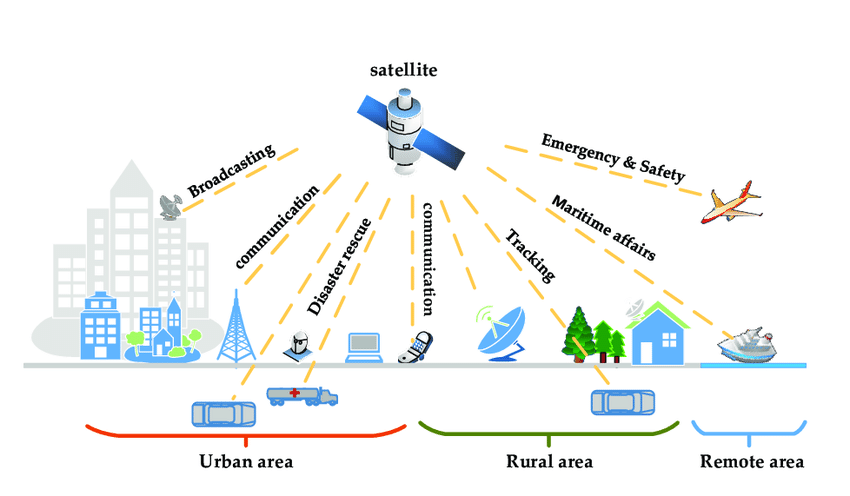Satellite Communication is a boom for providing ubiquitous connectivity in all terrains of the country through transforming the way of communication, and global connectivity and by bridging geographical barriers. This revolutionary technology enables the transmission of Voice, data and video signals over long distances using satellites. Thus, it plays a pivotal role in the development and growth of many important industries via data connectivity in the remotest areas of the countries.
In this blog, let’s unlearn the facts about Satellite Communication and its application in detail.
What is Satellite Communication?
The exchanging of information or messages from one place to another place using a communication satellite in orbit around the Earth is called Satellite Communication. It is an artificial satellite that transmits signals via a transponder by creating a channel between the transmitter and the receiver at different Earth locations. As a result, it opens various interaction channels between different regions that were unable to communicate with one another because of large distances and obstacles.
There are many industries such as telephone, radio, television, military applications and much more that are using satellite communication to transport their information. No doubt about the fact that there are 2000 satellites hurtling around in space above our heads.
Moreover, one of the largest domestic communication systems is India is Indian National Satellite (INSAT). It is placed in the geo-stational orbit. The INSAT operates multiple transponders that serve various functions, including telecommunications, weather forecasting, television broadcasting, and more.
Types of Satellites
The need for satellite communication has become important to transmit signals across the curvature. To transport these signals, satellite communication uses two types of artificial satellites:
-
Passive Satellites:
Passive satellites were the first form of communication satellites that reflects the signal back towards the Earth with amplification. To exemplify, imagine launching a hydrogen balloon coated with a metallic material into the sky. This ingenious approach transforms the balloon into a passive satellite, effectively harnessing its technological capabilities.
Note: Satellite orbits can span from 2000 to 35786 km, and the atmospheric attenuation significantly affects signal transmission and reception.
-
Active Satellites:
Active satellites serve the purpose of enhancing transmitted signals by amplifying them before relaying them back to Earth. This ensures excellent signal strength while transporting of signals.
As new technology is emerging, many industries are using these forms of satellites for transforming of signals.
Note: Every user has allocated a specific frequency for transmitting to avoid missing signals. This allocation of the frequency is done by International Telecommunication Union.
How Satellite Communication is Possible?
Communication refers to the transfer of data from one sender to a receiver (who will respond). This way of communication can only be possible by using any medium.
Communication is possible in different ways:
- Using light in an optical system.
- Radio signals to communicate in the ratio communication system.
- Telecommunication is used for communication via signals.
Satellite Communication Services
Satellites act as relay stations in orbit, receiving signals from ground-based stations and retransmitting them to other locations on Earth. Satellite communication uses two types of services for transporting the signals:
- One-way satellite communication
- Two-way satellite communication
Types of Satellite Communication
Satellite communication uses three types of satellites for seamless and wireless communication:
Fixed Satellite
Fixed satellite helps in data transmitting across the world through a permanent point on the surface of the earth.
Mobile Satellite
Mobile satellite is used for connecting aircraft, and ships at remote places.
Research Satellite
Research satellite aids in different research methods for the researchers. The satellite gathers the required data by using a research satellite system.
How do Satellite Communications Work?
Communication satellites are the same as any other space mirrors in space. It bounces back the signals via internet data, radio, and television from one side of the Earth to another. This working of satellite communication includes three stages:
- Uplink
- Transponders
- Downlink
Process of communication:
- The satellite is arranged in space to get the signals from one side of the earth to another by using an antenna. This stage is known as Uplink.
- These signals are improvised at the best level and then they are transmitted again back to the globe through transponders. The transponders boost the incoming signals and change their frequency so the outgoing signals shouldn’t be altered.
- In the last process, the earth station sends the data to the other end of the receiver on the Earth. This stage involves one uplink and many downlinks.
Hence, communication via satellite assists in signal transmission from the Earth and subsequently back to the Earth.
Satellite Communication Applications
With the new advancements and use of modern technologies in satellite industries, it provides healthy satellite services to broadcasters, Internet service providers, governments, and other sectors. Some of them are mentioned below.
Applications in satellite communication:
- Telephone
- Television
- Digital cinema
- Radio broadcasting
- Amateur radio
- Internet access
- Military
- Disaster Management
- Ships
Conclusion
A world cannot be imagined without the communication between two people. So, without interacting, there would be zero possibility of sharing and exchanging of ideas. Satellite communication makes communication easy and correct for the sender and the receiver. It offers advantages such as wide coverage, high-speed data transfer, and resilience to terrestrial infrastructure limitations. Thus, it has become an integral part of our modern communication infrastructure, connecting people and facilitating seamless communication worldwide.












